In Silico CFD Investigation of the Granulation Hydrodynamics in Rotating Drum: Process Sensitivity to the Operating Parameters and Drag Models
Abstract
:1. Introduction
2. CFD Model Setup
2.1. Governing Equations and Fluid-Solid Interactions
2.2. Drag Forces
2.3. Solid-Solid Interactions
3. Numerical Model Setup
3.1. Physical Parameters
3.2. Mesh Independence Analysis
4. Results and Discussion
4.1. Drag Model Effect on Hydrodynamics Predictions
4.1.1. Effect on the Particle Velocity
4.1.2. Effect on the Two-Phase Volume Fraction Distribution
4.2. Flow Sensitivity to Operating Conditions
4.2.1. Rotational Speed Effect
4.2.2. Filling Degree Effect
4.2.3. Inclination Degree Effect
5. Conclusions
Author Contributions
Funding
Institutional Review Board Statement
Informed Consent Statement
Data Availability Statement
Acknowledgments
Conflicts of Interest
References
- Dittmar, H. Fertilizers, 4. Granulation. In Ullmann’s Encyclopedia of Industrial Chemistry; Wiley-VCH: Weinheim, Germany, 2000. [Google Scholar]
- Artyukhov, A.; Sklabinskyi, V. Hydrodynamics of gas flow in small-sized vortex granulators in the production of Nitrogen fertilizers. Chem. Chem. Technol. 2015, 9, 337–342. [Google Scholar] [CrossRef]
- Saleh, K.; Guigon, P. Mise en œuvre des Poudres: Techniques de Granulation Humide et Liants. Techniques de l’ingénieur. Génie des Procédés, J2253. 2009. Available online: https://www.techniques-ingenieur.fr/base-documentaire/biomedical-pharma-th15/mise-en-forme-des-medicaments-et-autres-produits-de-sante-42611210/mise-en-uvre-des-poudres-j2254/ (accessed on 13 June 2022).
- Ntamo, D.; Lopez-Montero, E.; Mack, J.; Omar, C.; Highett, M.I.; Moss, D.; Mitchell, N.; Soulatintork, P.; Moghadam, P.Z.; Zandi, M. Industry 4.0 in Action: Digitalisation of a Continuous Process Manufacturing for Formulated Products. Digit. Chem. Eng. 2022, 3, 100025. [Google Scholar] [CrossRef]
- Le, V.G.; Vo, D.V.N.; Nguyen, N.H.; Shih, Y.J.; Vu, C.T.; Liao, C.H.; Huang, Y.H. Struvite recovery from swine wastewater using fluidized-bed homogeneous granulation process. J. Environ. Chem. Eng. 2021, 9, 105019. [Google Scholar] [CrossRef]
- Liu, B.; Wang, J.; Zeng, J.; Zhao, L.; Wang, Y.; Feng, Y.; Du, R. A review of high shear wet granulation for better process understanding, control and product development. Powder Technol. 2021, 381, 204–223. [Google Scholar] [CrossRef]
- Elmisaoui, S.; Khamar, L.; Benjelloun, S.; Khamar, M.; Ghidaglia, J.M. Numerical Study of fertilizer granules dynamics within rotary drum granulator. In Computer Aided Chemical Engineering; Elsevier: Amsterdam, The Netherlands, 2021; Volume 50, pp. 327–332. [Google Scholar]
- Vesjolaja, L.; Glemmestad, B.; Lie, B. Application of population balance equation for continuous granulation process in spherodizers and rotary drums. In Proceedings of the SIMS 2020 Virtual, Finland, 22–24 September 2021. [Google Scholar]
- Elmisaoui, S.; Elmisaoui, S.; Benjelloun, S.; Khamar, L.; Khamar, M. CFD Investigation of Industrial Gas-liquid Preneutralizer Based on a Bioreactor Benchmark for Spargers Optimization. Chem. Eng. Trans. 2022, 93, 73–78. [Google Scholar]
- Elmisaoui, S.; Khamar, L.; Benjelloun, S.; Khamar, M.; Ghidaglia, J. Modeling and Study of Hydrodynamic flow within the Preneutralizer Reactor using CFD Approach. In Computer Aided Chemical Engineering, Proceedings of the 30th European Symposium on Computer Aided Process Engineering, Milan, Italy, 24–27 May 2020; Elsevier: Amsterdam, The Netherlands, 2020; Volume 48, pp. 103–108. [Google Scholar]
- Fertahi, S.; Ilsouk, M.; Zeroual, Y.; Oukarroum, A.; Barakat, A. Recent trends in organic coating based on biopolymers and biomass for controlled and slow release fertilizers. J. Control. Release 2021, 330, 341–361. [Google Scholar] [CrossRef] [PubMed]
- Yang, R.Y.; Yu, A.B.; McElroy, L.; Bao, J. Numerical simulation of particle dynamics in different flow regimes in a rotating drum. Powder Technol. 2008, 188, 170–177. [Google Scholar] [CrossRef]
- Govender, I. Granular flows in rotating drums: A rheological perspective. Miner. Eng. 2016, 92, 168–175. [Google Scholar] [CrossRef]
- Arntz, M.M.H.D.; den Otter, W.K.; Briels, W.J.; Bussmann, P.J.T.; Beeftink, H.H.; Boom, R.M. Granular mixing and segregation in a horizontal rotating drum: A simulation study on the impact of rotational speed and fill level. AIChE J. 2008, 54, 3133–3146. [Google Scholar] [CrossRef]
- Pathmathas, T. Granular Flow Modelling of Rotating Drum Flows Using Positron Emission Particle Tracking. Ph.D. Thesis, University of Cape Town, Cape Town, South Africa, 2015. [Google Scholar]
- Santos, D.A.; Scatena, R.; Duarte, C.R.; Barrozo, M.A.S. Transition phenomenon investigation between different flow regimes in a rotary drum. Braz. J. Chem. Eng. 2016, 33, 491–501. [Google Scholar] [CrossRef]
- Nascimento, S.M.; Lima, R.M.; Brandão, R.J.; Duarte, C.R.; Barrozo, M.A.S. Eulerian study of flights discharge in a rotating drum. Can. J. Chem. Eng. 2019, 97, 477–484. [Google Scholar] [CrossRef]
- Santos, D.A.; Barrozo, M.A.S.; Duarte, C.R.; Weigler, F.; Mellmann, J. Investigation of particle dynamics in a rotary drum by means of experiments and numerical simulations using DEM. Adv. Powder Technol. 2016, 27, 692–703. [Google Scholar] [CrossRef]
- Kasper, J.H.; Magnanimo, V.; de Jong, S.D.M.; Beek, A.; Jarray, A. Effect of viscosity on the avalanche dynamics and flow transition of wet granular matter. Particuology 2021, 59, 64–75. [Google Scholar] [CrossRef]
- Burgos-Florez, F.; Bula, A.; Marquez, J.; Ferrer, A.; Sanjuan, M. CFD-DEM modeling and simulation coupled to a global thermodynamic analysis methodology for evaluating energy performance: Biofertilizer industry. Processes 2019, 7, 673. [Google Scholar] [CrossRef]
- Baba, T.; Nakamura, H.; Takimoto, H.; Ohsaki, S.; Watano, S.; Takehara, K.; Higuchi, T.; Hirosawa, T.; Yamamoto, T. DEM–PBM coupling method for the layering granulation of Iron ore. Powder Technol. 2021, 378, 40–50. [Google Scholar] [CrossRef]
- Zhao, J.; Shan, T. Numerical modeling of fluid-particle interaction in granular media. Theor. Appl. Mech. Lett. 2013, 3, 021007. [Google Scholar] [CrossRef]
- Hayashi, K.; Nakamura, H.; Watano, S. Numerical study on granule aggregation and breakage in fluidized bed granulation by a novel PBM with DEM-CFD coupling approach. Powder Technol. 2020, 360, 1321–1336. [Google Scholar] [CrossRef]
- Delele, M.A.; Weigler, F.; Franke, G.; Mellmann, J. Studying the solids and fluid flow behavior in rotary drums based on a multiphase CFD model. Powder Technol. 2016, 292, 260–271. [Google Scholar] [CrossRef]
- Nieuwland, J.J.; van Sint Annaland, M.; Kuipers, J.A.M.; van Swaaij, W.P.M. Hydrodynamic modeling of gas/particle flows in riser reactors. AIChE J. 1996, 42, 1569–1582. [Google Scholar] [CrossRef]
- Wang, W.; Lu, B.; Geng, J.; Li, F. Mesoscale drag modeling: A critical review. Curr. Opin. Chem. Eng. 2020, 29, 96–103. [Google Scholar] [CrossRef]
- Du, W.; Bao, X.; Xu, J.; Wei, W. Computational fluid dynamics (CFD) modeling of spouted bed: Assessment of drag coefficient correlations. Chem. Eng. Sci. 2006, 61, 1401–1420. [Google Scholar] [CrossRef]
- Upadhyay, M.; Kim, A.; Kim, H.; Lim, D.; Lim, H. An Assessment of Drag Models in Eulerian–Eulerian CFD Simulation of Gas–Solid Flow Hydrodynamics in Circulating Fluidized Bed Riser. ChemEngineering 2020, 4, 37. [Google Scholar] [CrossRef]
- Schiller, L.; Naumann, A. A drag coefficient correlation. Z. Vereins Dtsch. Ingenieure 1935, 77, 318–320. [Google Scholar]
- Helland, E.; Bournot, H.; Occelli, R.; Tadrist, L. Drag reduction and cluster formation in a circulating fluidised bed. Chem. Eng. Sci. 2007, 62, 148–158. [Google Scholar] [CrossRef]
- Wen, C.Y.; Yu, H.Y. Chemical engineering progress symposium series. Mech Fluid 1966, 62, 100–111. [Google Scholar]
- Gidaspow, D. Multiphase Flow and Fluidization: Continuum and Kinetic Theory Descriptions; Academic Press: Cambridge, MA, USA, 1994. [Google Scholar]
- Syamlal, M.; O’Brien, T.J. The Derivation of a Drag Coefficient Formula from Velocity-Voidage Correlations; Technical Note; US Department of energy, Office of Fossil Energy, NETL: Morgantown, WV, USA, 1987. [Google Scholar]
- Khalilitehrani, M.; Abrahamsson, P.J.; Rasmuson, A. Modeling dilute and dense granular flows in a high shear granulator. Powder Technol. 2014, 263, 45–49. [Google Scholar] [CrossRef]
- Chao, Z.; Wang, Y.; Jakobsen, J.P.; Fernandino, M.; Jakobsen, H.A. Investigation of the particle–particle drag in a dense binary fluidized bed. Powder Technol. 2012, 224, 311–322. [Google Scholar] [CrossRef]
- Lun, C.K.K. Kinetic theory for granular flow of dense, slightly inelastic, slightly rough spheres. J. Fluid Mech. 1991, 233, 539–559. [Google Scholar] [CrossRef]
- Schaeffer, D.G. Instability in the evolution equations describing incompressible granular flow. J. Differ. Equ. 1987, 66, 19–50. [Google Scholar] [CrossRef]
- Chmielewski, M.; Gieras, M. Three-zonal wall function for k-ε turbulence models. Comput. Methods Sci. Technol. 2013, 19, 107–114. [Google Scholar] [CrossRef]
- Hou, Z.; Zhao, Y. Numerical and experimental study of radial segregation of bi-disperse particles in a quasi-two-dimensional horizontal rotating drum. Particuology 2020, 51, 109–119. [Google Scholar] [CrossRef]
- Santos, D.A.; Petri, I.J.; Duarte, C.R.; Barrozo, M.A.S. Study of hybrid drag models for predicting hydrodynamic behaviour in a spouted bed. Can. J. Chem. Eng. 2013, 11, 1776–1785. [Google Scholar] [CrossRef]
- Adnan, M.; Sun, J.; Ahmad, N.; Wei, J.J. Validation and sensitivity analysis of an Eulerian–Eulerian two-fluid model (TFM) for 3D simulations of a tapered fluidized bed. Powder Technol. 2022, 396, 490–518. [Google Scholar] [CrossRef]
- Santos, D.A.; Petri, I.J.; Duarte, C.R.; Barrozo, M.A.S. Experimental and CFD study of the hydrodynamic behavior in a rotating drum. Powder Technol. 2013, 250, 52–62. [Google Scholar] [CrossRef]
- Tamburini, A.; Cipollina, A.; Micale, G.; Brucato, A.; Ciofalo, M. Influence of drag and turbulence modelling on CFD predictions of solid liquid suspensions in stirred vessels. Chem. Eng. Res. Des. 2014, 92, 1045–1063. [Google Scholar] [CrossRef]
- Alagha, M.S.; Szentannai, P. Experimentally-assessed multi-phase CFD modeling of segregating gas–solid fluidized beds. Chem. Eng. Res. Des. 2021, 172, 215–225. [Google Scholar] [CrossRef]
- Wu, X.; Zuo, Z.; Gong, S.; Lu, X.; Xie, G. Numerical study of size-driven segregation of binary particles in a rotary drum with lower filling level. Adv. Powder Technol. 2021, 32, 4765–4778. [Google Scholar] [CrossRef]
- Rahman, R.; Zhu, H.; Yu, A. Numerical analysis of effects of specularity coefficient and restitution coefficient on the Hydrodynamics of particles in a rotating Drum. Processes 2022, 10, 167. [Google Scholar] [CrossRef]
- Sandadi, S.; Pandey, P.; Turton, R. In situ, near real-time acquisition of particle motion in rotating pan coating equipment using imaging techniques. Chem. Eng. Sci. 2004, 59, 5807–5817. [Google Scholar] [CrossRef]
- Norouzi, H.R.; Zarghami, R.; Mostoufi, N. Insights into the granular flow in rotating drums. Chem. Eng. Res. Des. 2015, 102, 12–25. [Google Scholar] [CrossRef]
- Li, S.Q.; Yan, J.H.; Li, R.D.; Chi, Y.; Cen, K.F. Axial transport and residence time of MSW in rotary kilns: Part I. Experimental. Powder Technol. 2002, 126, 217–227. [Google Scholar] [CrossRef]
- Rogers, R.S.C.; Gardner, R.P. A Monte Carlo method for simulating dispersion and transport through horizontal rotating cylinders. Powder Technol. 1979, 23, 159–167. [Google Scholar] [CrossRef]
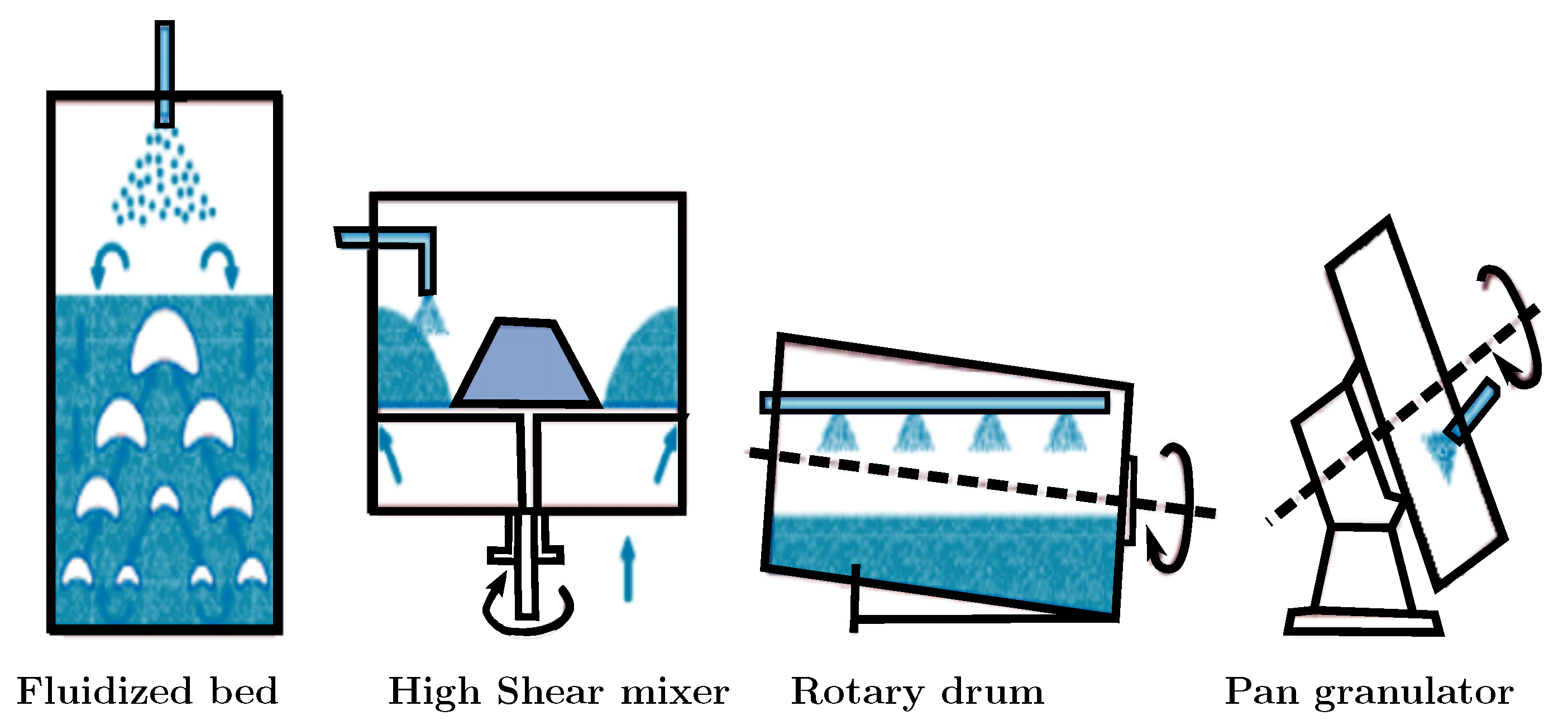



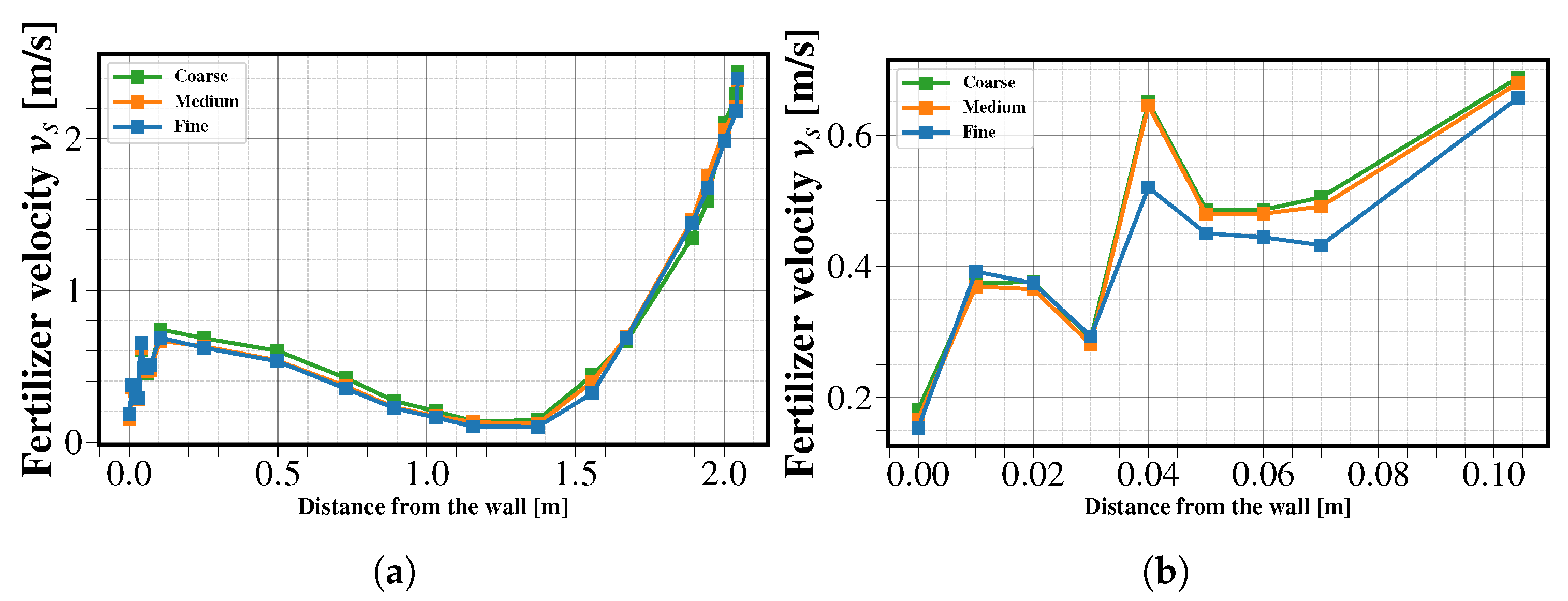
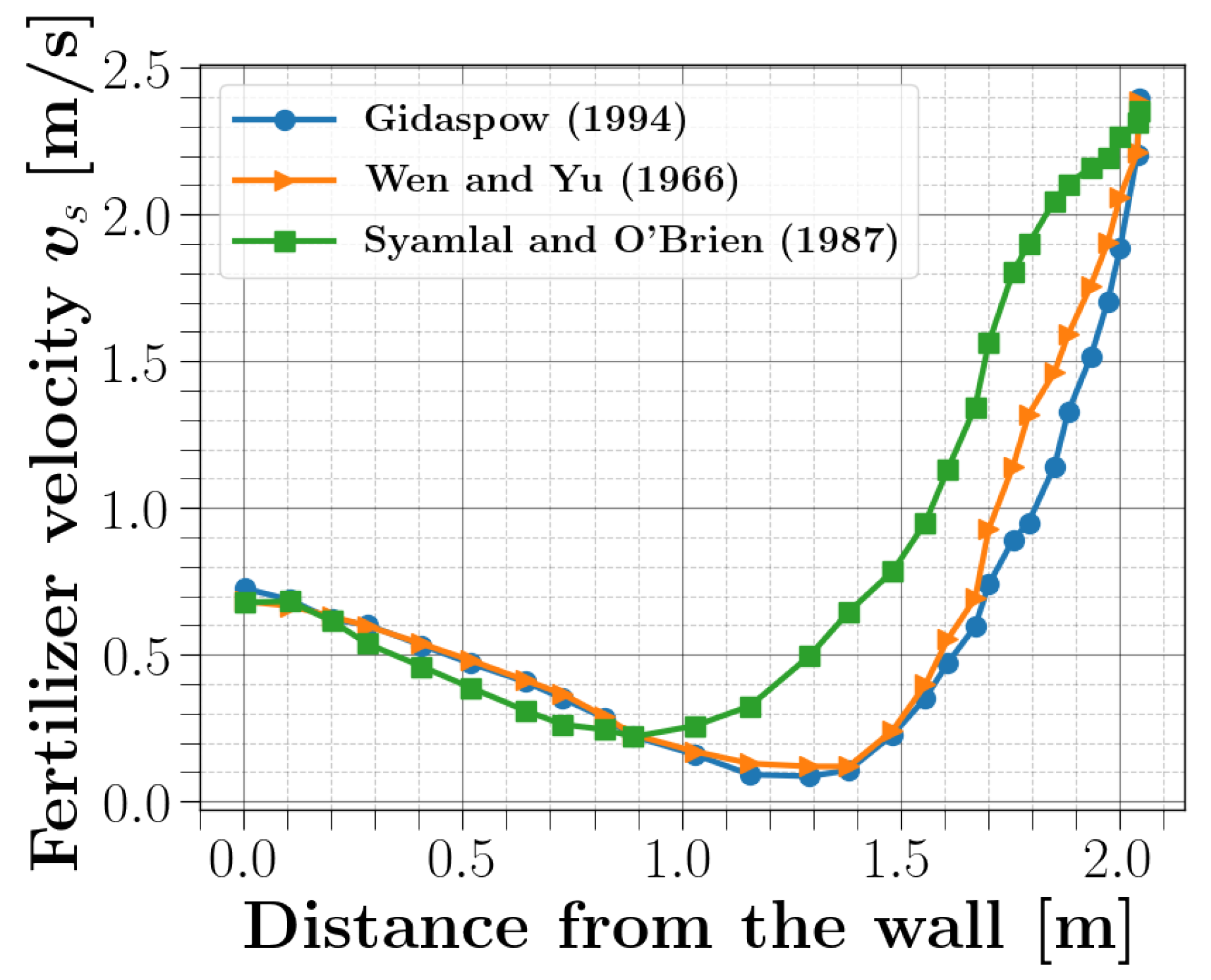
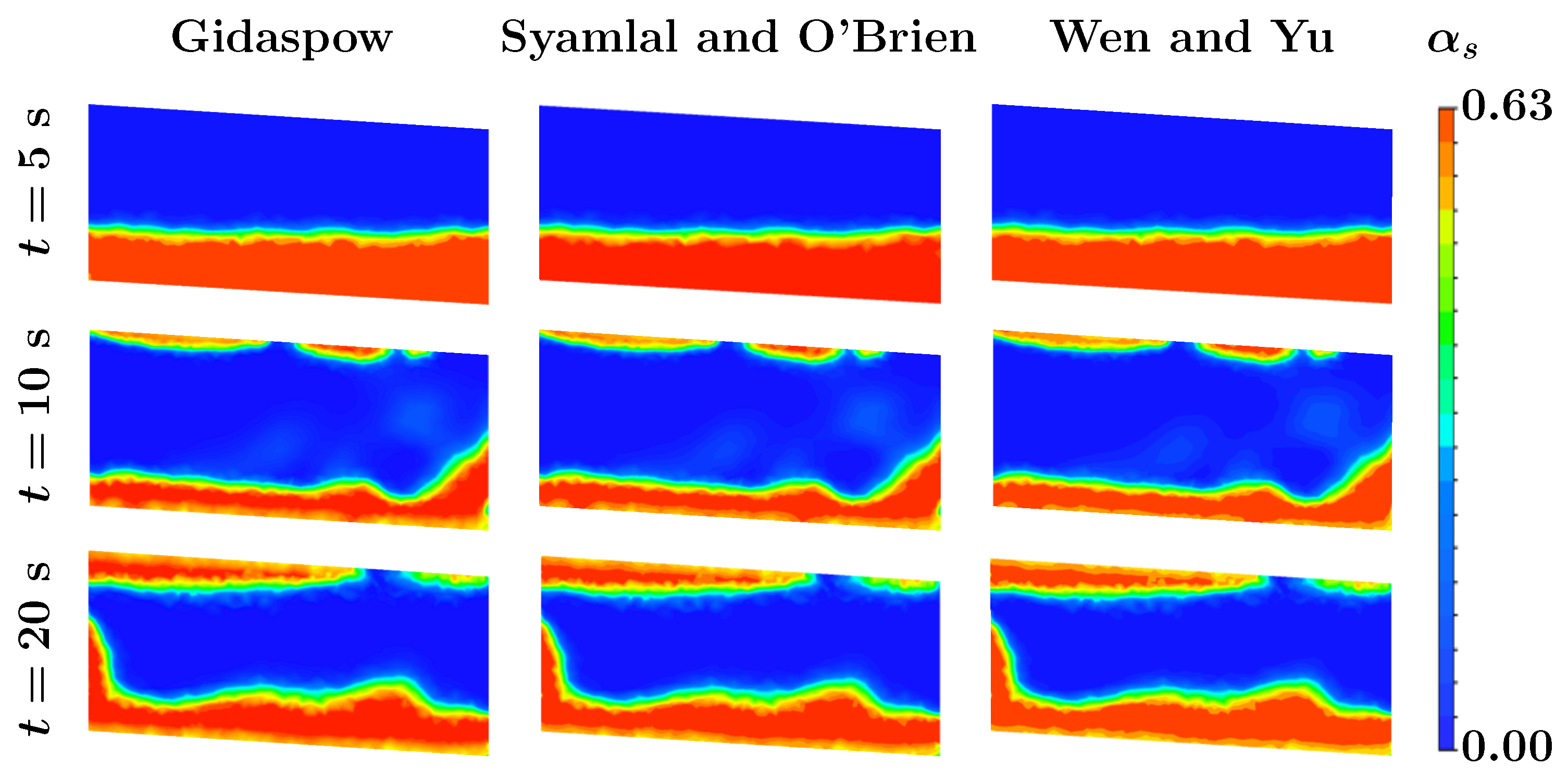

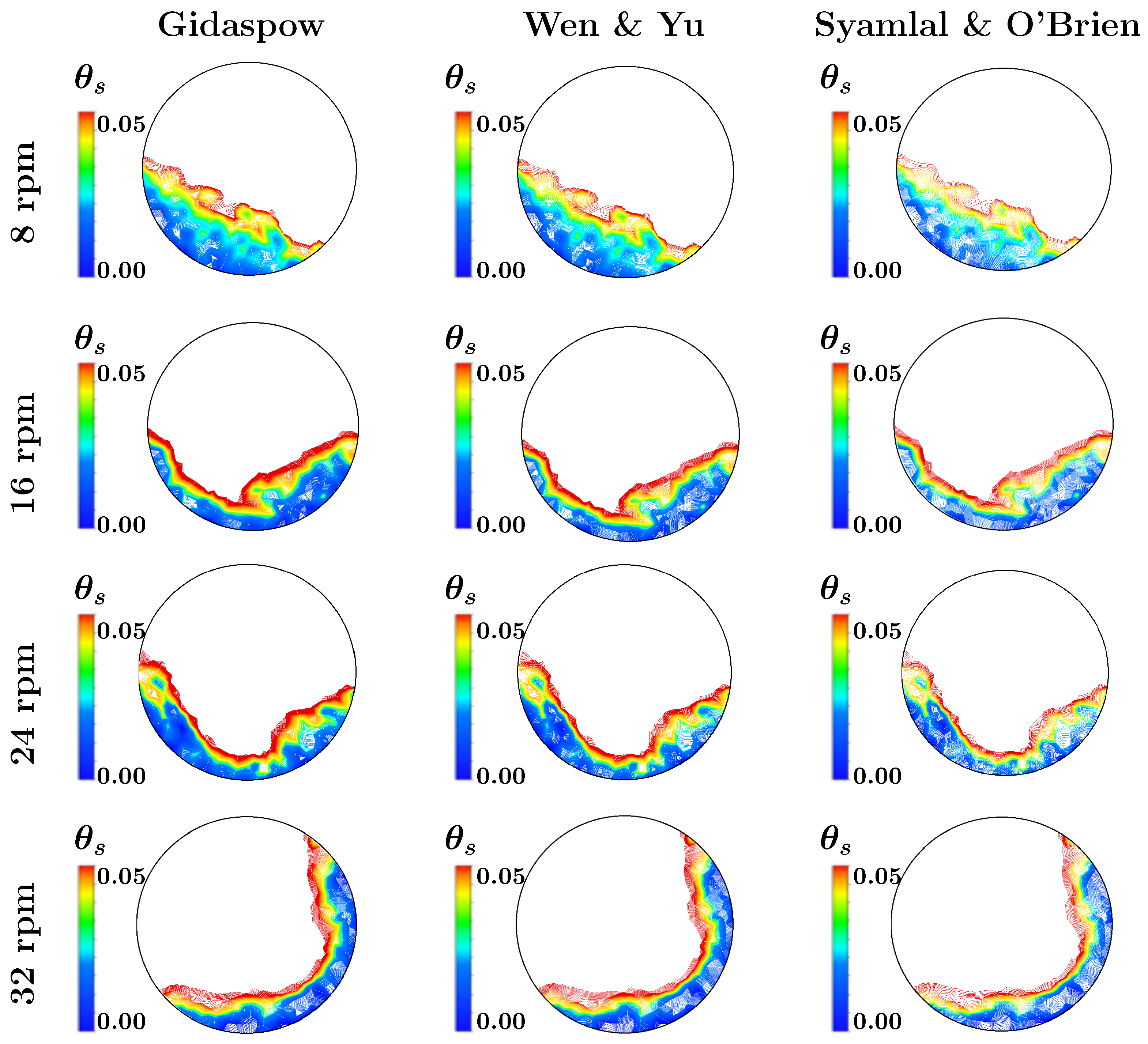

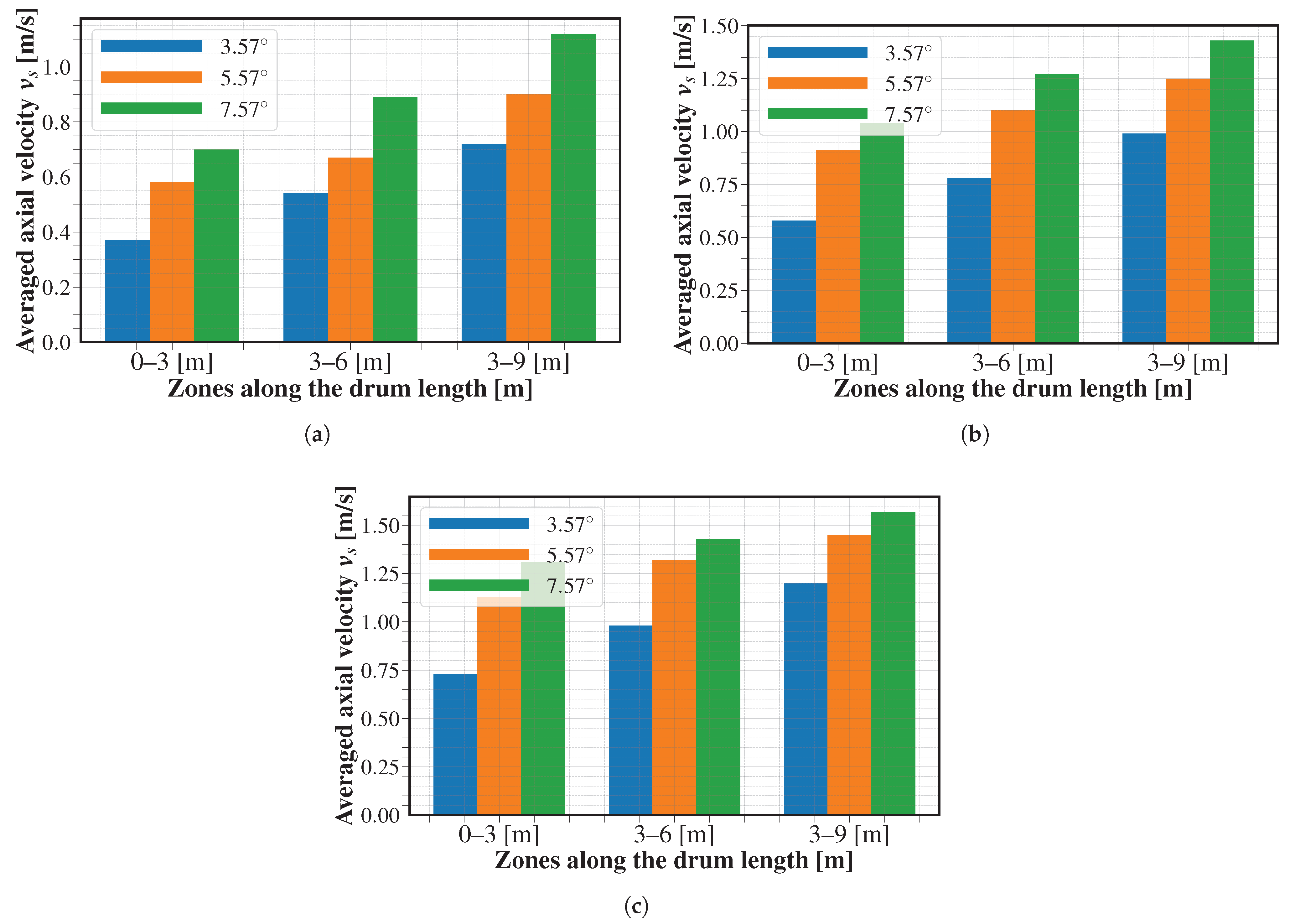
| Physical Property | Value |
|---|---|
| Air density () | kg/m |
| Air viscosity () | kg/m·s |
| Fertilizer particles density () | 1574 kg/m |
| Fertilizer particles diameter () | 2 mm |
Publisher’s Note: MDPI stays neutral with regard to jurisdictional claims in published maps and institutional affiliations. |
© 2022 by the authors. Licensee MDPI, Basel, Switzerland. This article is an open access article distributed under the terms and conditions of the Creative Commons Attribution (CC BY) license (https://creativecommons.org/licenses/by/4.0/).
Share and Cite
Elmisaoui, S.; Benjelloun, S.; Boukharfane, R.; Khamar, L.; Elmisaoui, S.; Khamar, M. In Silico CFD Investigation of the Granulation Hydrodynamics in Rotating Drum: Process Sensitivity to the Operating Parameters and Drag Models. Processes 2022, 10, 1939. https://doi.org/10.3390/pr10101939
Elmisaoui S, Benjelloun S, Boukharfane R, Khamar L, Elmisaoui S, Khamar M. In Silico CFD Investigation of the Granulation Hydrodynamics in Rotating Drum: Process Sensitivity to the Operating Parameters and Drag Models. Processes. 2022; 10(10):1939. https://doi.org/10.3390/pr10101939
Chicago/Turabian StyleElmisaoui, Safae, Saad Benjelloun, Radouan Boukharfane, Lhachmi Khamar, Sanae Elmisaoui, and Mohamed Khamar. 2022. "In Silico CFD Investigation of the Granulation Hydrodynamics in Rotating Drum: Process Sensitivity to the Operating Parameters and Drag Models" Processes 10, no. 10: 1939. https://doi.org/10.3390/pr10101939
APA StyleElmisaoui, S., Benjelloun, S., Boukharfane, R., Khamar, L., Elmisaoui, S., & Khamar, M. (2022). In Silico CFD Investigation of the Granulation Hydrodynamics in Rotating Drum: Process Sensitivity to the Operating Parameters and Drag Models. Processes, 10(10), 1939. https://doi.org/10.3390/pr10101939





